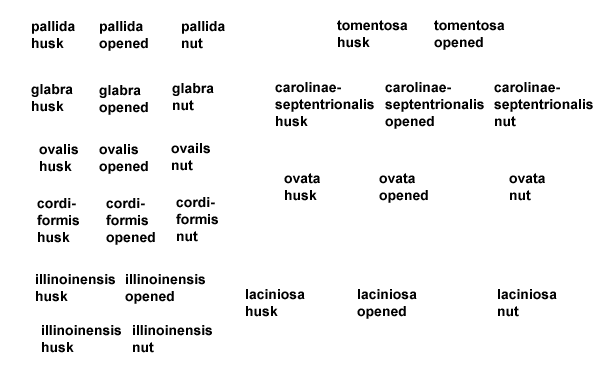
 |
Carya Fruits (hickory nuts) |
Compare features of Carya (hickory)
species
Key to southeastern U.S. Carya
(hickory) species
Jump to descriptions of fruits
Hickory fruits consist of hard-shelled nuts, surrounded by a
woody husk. The husk varies among species as to how easily it splits and
whether the sutures are winged along part or all of their length. The nuts
are edible, although they vary in size and taste.
 |
Individual Carya fruits. Click on an image for a larger view. Written descriptions from: Chester EW, RJ Jensen, LJ Schibig, S. Simoni. 1987. The Nut Trees of Land Between The Lakes. The Center for Field Biology of Land Between The Lakes, Austin Peay University, Clarksville, TN



Carya carolinae-septentrionalis (southern shagbark hickory):
often broader than high, 2 to 4 cm wide; the husk 3 to 9 mm thick, splitting
freely to near the base; nut ovoid, prominently four-angled, with a thin shell;
kernel light brown and sweet.



Carya
cordiformis



Carya
glabra
 |
 |
 |
|
Carya illinoinensis (pecan): 3.8 to 5 cm long, oblong, in clusters of 3 to 6; husk thin, narrowly four-winged, dark brown, hairy; nut elongate, rounded at the base and pointed at the tip, brown; shell thin; kernel oily and sweet.


Carya
laciniosa (shellbark hickory or kingnut hickory): the largest of any
hickory [in the area], 4.5 to 6.5 cm long and 3.8 cm broad, occurring singly or
in pairs; thick husk splitting readily into segments when ripe; nut flattened,
ridged; shell very thick and hard; kernel sweet.


Carya
ovalis (red hickory): 2.5 to 3 cm long and about 2 cm wide; husk
thin, about 2 to 2.5 mm thick, splitting freely to the base; nut with ridges
extending from 1/3 to 1/2 its length; shell thin; kernel small and sweet.


Carya
ovata

Carya palida (sand hickory): small, 13 to 37 mm long, somewhat
rounded, slightly longer than broad, covered with short hairs and yellow scales;
husk thin, 3 to 4 mm thick and splitting tardily to the base by 2 or 3 sutures;
nut laterally flattened, ridged, light-colored; shell very thin, 2 to 3 mm
thick; kernel sweet.



Carya
tomentosa